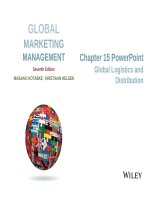Lecture international marketing (16th edition) chapter 15: international marketing channels
Bạn đang xem bản rút gọn của tài liệu. Xem và tải ngay bản đầy đủ của tài liệu tại đây (459.12 KB, 29 trang )
International Marketing
Channels
Chapter 15
McGraw-Hill/Irwin
Copyright © 2013 by The McGraw-Hill Companies, Inc. All rights reserved.
Learning Objectives
LO1 The variety of distribution channels and how they affect cost
and efficiency in marketing
LO2 The Japanese distribution structure and what it means to
Japanese customers and to competing importers of goods
LO3 How distribution patterns affect the various aspects
of international marketing
LO4 The functions, advantages, and disadvantages of various kinds
of middlemen
LO5 The importance of selecting and maintaining middlemen
LO6 The growing importance of e-commerce as a distribution
alternative
LO7 The interdependence of physical distribution activities
15-2
Channel-of-Distribution
Structures
• The distribution process
– physical handling and distribution of goods,
– the passage of ownership (title), and
– the buying and selling negotiations between producers
and middlemen and between middlemen and customers
• Channel structures range from those with little
developed marketing infrastructure such as those
found in many emerging markets to the highly
complex, multi-layered system found in Japan
15-3
International Distribution
Systems
• Import-Oriented Distribution Structure
• Tight distribution structures: Japan
• Trends: From Traditional to Modern Channel
Structures
15-4
Import-Oriented Distribution
Structures
In an import-oriented or traditional distribution
structure, an importer controls a fixed supply of
goods
The marketing system develops around the
philosophy of selling a limited supply of goods at
high prices to a small number of affluent customers
In the resulting seller’s market, market penetration
and mass distribution are not necessary because
demand exceeds supply, and in most cases
15-5
Import-Oriented Distribution
Structures
The customer seeks the supply from a limited
number of middlemen and this affects the
development of intermediaries and their functions.
Distribution systems are local rather than national in
scope
The relationship between the importer and any
middleman in the marketplace is considerably
different from a mass-marketing system, the
importer performs all the functions
15-6
Japanese Distribution Structure
Distribution in Japan has long been considered the most
effective non-tariff barrier to the Japanese market The
Japanese distribution structure is different enough from its
U.S. or European counterparts
It has four distinguishing features:
1.
2.
3.
4.
A structure dominated by many small middlemen dealing with
many small retailers—high density of middlemen
Channel control by manufacturers
A business philosophy shaped by a unique culture and
Laws that protect the foundation of the system—the small retailer
15-7
15-8
Japanese Distribution Structure
15-9
Channel Control in Japanese
Distribution Systems
15-10
Trends: From Traditional to
Modern Channel Structures
Traditional channel structures still appear in many places
But such channel structures also are giving way to new
forms, new alliances, and new processes
Direct marketing, door-to-door selling, hypermarkets,
discount houses, shopping malls, catalog selling, the
Internet, and other distribution methods are being
introduced in an attempt to provide efficient distribution
channels
Importers and retailers also are becoming more involved
in new product development
15-11
Distribution Patterns
The “traditional” system will not change overnight
Nearly all international firms are forced by the
structure of the market to use at least some
middlemen in the distribution arrangement
Because the structural arrangements of foreign and
domestic distribution seem alike, does not mean that
foreign channels are similar to domestic channels
The differences in retail patterns is an example of the
variety of distribution patterns that exist at all levels
15-12
Retail Patterns
Retailing shows even greater diversity in its structure
than does wholesaling
Size Patterns
• Large dominant retailers can be sold to directly, but there
is no adequate way to reach small retailers who, in the
aggregate, handle a great volume of sales
• Underdeveloped countries present similar problems
• The rate of change appears to be directly related to the
stage and speed of economic development
15-13
Retail Patterns
Direct Selling
• Sometimes called direct marketing, selling directly to the
consumer through mail, by telephone, or door-to-door is
often the approach in markets with insufficient or
underdeveloped distribution systems
• The approach works well in the most affluent markets too
Resistance to Change
• Efforts to improve the efficiency of the distribution system,
new types of middlemen, and other attempts to change
traditional ways are typically viewed as threatening and
are thus resisted
15-14
15-15
Alternative Middlemen Choices
A marketer’s options range from assuming the entire
distribution activity (by establishing its own subsidiaries
and marketing directly to the end user) to depending on
intermediaries for distribution of the product
Channel selection must be given considerable thought,
because once initiated, is difficult to change, and if it
proves inappropriate, future growth of market share may
be impacted
The channel process includes all activities, beginning with
the manufacturer and ending with the final consumer
15-16
15-17
Home-Country Middlemen
Home-country middlemen, or domestic middlemen,
provide marketing services from a domestic base and
find foreign markets for products for local
manufacturers
15-18
Frequently Used Types of Domestic
Intermediaries
Manufacturers’ Retail Stores
Global Retailers
Export Management
Companies
Trading Companies
U.S. Export Trading
Companies
Complementary Marketers
Manufacturer’s Export
Agent
Home-Country Brokers
Buying Offices
Selling Groups
Webb-Pomerene Export
Associations
Foreign Sales Corporation
Export Merchants
Export Jobbers
15-19
Foreign Country Middlemen
The variety of agent and merchant middlemen in most countries is
similar to that in the United States
International marketers seeking greater control over the distribution
process may elect to deal directly with middlemen in the foreign
market
They gain the advantage of shorter channels and deal with middlemen
in constant contact with the market
Using foreign-country middlemen moves the manufacturer closer to
the market and involves the company more closely with problems of
language, physical distribution, communications, and financing
Foreign middlemen may be agents or merchants, they may be
associated with the parent company to varying degrees, or they may
be hired temporarily for special purposes
15-20
Foreign-Country Middlemen
Some of the more important foreign-country
middlemen, who find markets for foreign
manufacturers include:
•
•
•
•
•
•
Manufacturer’s Representatives
Distributors
Foreign-Country Brokers
Managing Agents and Compradors
Dealers
Import Jobbers, Wholesalers, and Retailers
15-21
Government-Affiliated
Middlemen
Marketers must deal with governments in every
country of the world
Products, services, and commodities for the
government’s own use are always procured through
government purchasing offices at federal, regional,
and local levels
In many countries such as the Netherlands, the
Government purchases from a lot of suppliers, and a
large percentage of the suppliers may be located in
other countries
15-22
Factors Affecting Channel
Choice
The selection process involves the following:
1.
2.
3.
4.
Identify specific target markets within and across
countries.
Specify marketing goals in terms of volume, market
share, and profit margin requirements.
Specify financial and personnel commitments to the
development of international distribution.
Identify control, length of channels, terms of sale, and
channel ownership
15-23
Six C’s of Channel Strategy
1.
2.
3.
4.
5.
6.
Cost
Capital Requirements
Control
Coverage
Character
Continuity
15-24
Channel Management
Many companies have been stopped in their efforts
to develop international markets by their inability to
construct a satisfactory system of channels.
Construction of the middleman network includes
seeking out potential middlemen, selecting those
who fit the company’s requirements, and
establishing working relationships with them
The closer the company wants to get to the
consumer in its channel contact, the larger the sales
force required
15-25









